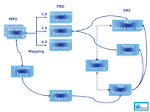Software Test Plan (STP) was initially required (Since 1994) by the regulated quality procedures with the objective to “establish uniform requirements for software development and documentation.” The STP demanding to verify that our testing coverage procedures will perfectly meet our requirements objectives, but can we really follow this document progress and report on its quality or this is one of those demands that we always meet but very rarely invest resources to track it. In order to meet the standard here are some key points that should be mentioned in such document
The DIDs are:
· Software Development Plan (SDP) - A plan for performing the software development
· Software Test Plan (STP) - A plan for conducting qualification testing
· Software Installation Plan (SIP) - A plan for installing the software at user sites
· Software Transition Plan (STrP) - A plan for transitioning to the support agency
· Operational Concept Description (OCD) - The operational concept for the system
· System/Subsystem Specification (SSS) - The requirements to be met by the system
· Software Requirements Specification (SRS) - The requirements to be met by a Computer Software Configuration Item (CSCI)
· Interface Requirements Specification (IRS) - The requirements for one or more interfaces
· System/Subsystem Design Description (SSDD) - The design of the system
· Software Design Description (SDD) - The design of a CSCI
· Interface Design Description (IDD) - The design of one or more interfaces
· Database Design Description (DBDD) - The design of a database
· Software Test Description (STD) - Test cases/procedures for qualification testing
· Software Test Report (STR) - Test results of qualification testing
· Software Product Specification (SPS) - The executable software, the source files, and information to be used for support
· Software Version Description (SVD) - A list of delivered file and related information
· Software User Manual (SUM) - Instructions for hands-on users of the software
· Software Input/Output Manual (SIOM) - Instructions for users of a batch or interactive software system that is installed in a computer center
· Software Center Operator Manual (SCOM) - Instructions for operators of a batch or interactive software system that is installed in a computer center
· Computer Operation Manual (COM) - Instructions for operating a computer
· Computer Programming Manual (CPM) - Instructions for programming a computer
· Firmware Support Manual (FSM) - Instructions for programming firmware devices
With so many items to follow it is almost impossible to do it without the use of ALM 2.0 tool (http://www.orcanos.com/qpack_alm_for_software_overview.htm ). In most cases we need to find good motivation to invest so much effort to meet this task.
On the practical side a test plan is made of two words Test and Plan. Two separate words but one focus, a plan for testing. Project plans are constantly adjusted around the triangle of scope, time and resources. In my mind a test plan is a sub-project plan focused on testing within the project. As the scope, time or resources change the test plan must adjust as well. The major objectives in the project plan need to me maintained and checks and balances of achievements should be reflected in the test plan. To follow the test plan is to follow the project plan or in most cases the release agenda based on list of requirements that needs to be meet by the project scoop. If we don't have a test plan or if we don't follow the test plan then we increase risk of missing a goal within the project plan and therefore risk the failure of the project. Can you cover everything? In most cases we can't cover everything in the project plan or the test plan. Therefore we need tools such as ALM 2.0 (http://www.orcanos.com/testing_tools_for_test_management.htm) that will also be able to measure the risk by not covering the key items in the STP. The main goal of testing is to address and communicate risk. We don't fix code, we don't set goals, we don't require features...we make sure that goals and features are in place and their dysfunction is addressed or mitigated. A good test plan is like a road map that's up to and contain only what is necessary. It refers to the leads or managers test plan, rather than being a duplicate with a few additional lines and changes here and there and that is just for the sake of “We were told to do so”. But if our tools allows us to defined the STP but at the same time to track the coverage matrix (http://www.orcanos.com/QPack_analytics.htm) using analytics reports. So what best practice tells us about good STP, its should provide enough detail and scope to unambiguously test an action or function (etc.). That said there is ALWAYS room to expand on them to expose corner conditions, race conditions, concurrent incompatible parameters and anything else you can think of. That's why you take notes during testing. So that you have a log to assist you in describing bugs and writing new test cases. This is why your ALM 2.0 tools should be capable to empress all the diverse activities in the project in one tool, and testing management is just one of them. Using good testing tool (http://www.orcanos.com/testing_tools_for_test_management.htm ) will allows you to build on top of your STP the test coverage and at the same time allows to reuse existing tests for different scoop of your STP.
Saturday, December 26, 2009
Wednesday, December 23, 2009
The Blurry Line between ALM and PLM
Application Lifecycle Management (ALM) and Product lifecycle Management (PLM) have different technology management perspectives—the first focuses on software development methodology system architecture, software validation, coverage matrix and impact analysis whereas the second focuses on taking care of innovation processes by facilitating product definition collaboration. However, there is an intersection between the two systems. By empowering the consistent accessibility of one system's stakeholders to another system's data and processes, the integration between the two systems delivers benefits such as shorter time-to-market, lower manufacturing costs, and higher customer satisfaction.
Monday, December 21, 2009
Why External UI Testing Matters
Software Engineer Brian Driscoll uses an unpleasant client post-mortem to explain the importance of testing UI with external testers. Read more
http://www.brian-driscoll.com/2009/12/why-external-ui-testing-matters.html
http://www.brian-driscoll.com/2009/12/why-external-ui-testing-matters.html
Labels:
alm 2.0,
Project Management,
test case,
test execution,
test management,
test run
Sunday, December 20, 2009
How does technology affects product marketing?
Increasing usage of social media and web 2.0 by companies and customers has changed and also has added many roles in organizations. My question is how product management and product marketing roles have been affected by this new wave?
Thursday, December 17, 2009
Testing the Limits with James Bach
This is an interesting article worth reading for those of you that belongs to the Testing domain.
http://blog.utest.com/testing-the-limits-with-james-bach-part-1/2009/12/
http://blog.utest.com/testing-the-limits-with-james-bach-part-1/2009/12/
Wednesday, November 25, 2009
How you build your product vision
What factors need to be considered by architects, product managers and development teams for creating product vision?
What drives the definition of a vision that leads to a successful and competitive product?
http://www.linkedin.com/redirect?url=http%3A%2F%2Fbit%2Ely%2F3Thivl&urlhash=wxr_
What drives the definition of a vision that leads to a successful and competitive product?
http://www.linkedin.com/redirect?url=http%3A%2F%2Fbit%2Ely%2F3Thivl&urlhash=wxr_
Thursday, November 5, 2009
Skills of a Successful Project Manager
In his book, "The Little Black Book of Project Management," Michael Thomsett identifies his version of the skillset of a successful project manager. I'm providing it here to give you yet another take on some of the key characteristi…
Those 8 qualification are excellent but it is not enough to be able to define them but there should be also methods and tools that needs to support most of those qualifications. In most cases the project manager spend a lot of time to collect the information he need in order to make a decision. In that case a decision support system will allow the project manager 1. to be alert ahead of time on project risks 2. to collaborate with all team in all locations via ALM 2.0 tools 3. to communicate with all stakeholders 4. to trace back deliveries to customer requirements 5. to transform customer request into change management system 6. to analysis the impact of a change on the overall project. ALM 2.0 tools were build to all this work and more. Take a look at this FREE tool http://www.orcanos.com/QPack_for_software.htm or any other tool that meets ALM 2.0 qualifications.
Those 8 qualification are excellent but it is not enough to be able to define them but there should be also methods and tools that needs to support most of those qualifications. In most cases the project manager spend a lot of time to collect the information he need in order to make a decision. In that case a decision support system will allow the project manager 1. to be alert ahead of time on project risks 2. to collaborate with all team in all locations via ALM 2.0 tools 3. to communicate with all stakeholders 4. to trace back deliveries to customer requirements 5. to transform customer request into change management system 6. to analysis the impact of a change on the overall project. ALM 2.0 tools were build to all this work and more. Take a look at this FREE tool http://www.orcanos.com/QPack_for_software.htm or any other tool that meets ALM 2.0 qualifications.
Subscribe to:
Posts (Atom)




